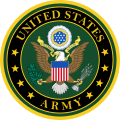This article needs additional citations for verification .(February 2013) |
The U.S. Army enlisted rank insignia that was used during World War II differs from the current system. The color scheme used for the insignia's chevron design was defined as golden olive drab chevrons on a dark blue-black wool background for wear on "winter" uniform dress coats and dress shirts or silvery-khaki chevrons on a dark blue-black cotton background for wear on the various types of field jackets and "winter" uniform fatigue shirts. An unauthorized variant that nevertheless saw wide use was olive drab chevrons on a khaki cotton background for wear on the "summer" uniform dress coats (introduced in 1929 and discontinued for issue in 1938) and dress shirts. This scheme of rank insignia was established by War Department Circular No. 303 on 5 August 1920 and would see two significant changes in 1942. The usage of this style of insignia was ended by Department of the Army Circular No. 202, dated 7 July 1948, which provided for significant changes in both rank and insignia design.
Contents
- Pay grades, 1920-1942
- Enlisted men
- Rank insignia, 1920–1942
- Pay grades, 1942-1948
- Rank insignia, 1942–1948
- Technicians
- First sergeant
- Abbreviations
- Comparative chart
- See also
- Citations
- General sources












